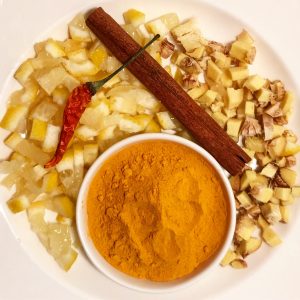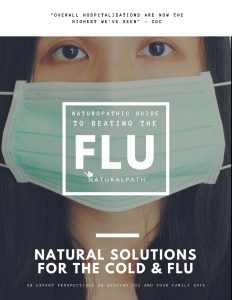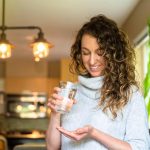Turmeric Has a History as Both Food and Medicine
 Traditionally it has been used to treat small pox, arthritis, liver disease, digestive problems, menstrual disorders, and cancer, as well as respiratory conditions and infections.1 Curcumin, one of the active compounds inside turmeric, may be best known for its anti-inflammatory activity, but research studies show that it also has a wide range of antiviral activity. It can inhibit herpes simplex virus, hepatitis B virus, Japanese encephalitis virus, human T-cell leukemia virus type 1 which has been linked to blood cancer, and human papillomaviruses including high-risk HPV-16 and HPV-18 which have been associated with cervical cancer.2 Turmeric can also inhibit influenza viruses, including H1N1.2 Influenza viruses treated with prescription antiviral drugs can develop resistance, but those treated with turmeric do not.3
Traditionally it has been used to treat small pox, arthritis, liver disease, digestive problems, menstrual disorders, and cancer, as well as respiratory conditions and infections.1 Curcumin, one of the active compounds inside turmeric, may be best known for its anti-inflammatory activity, but research studies show that it also has a wide range of antiviral activity. It can inhibit herpes simplex virus, hepatitis B virus, Japanese encephalitis virus, human T-cell leukemia virus type 1 which has been linked to blood cancer, and human papillomaviruses including high-risk HPV-16 and HPV-18 which have been associated with cervical cancer.2 Turmeric can also inhibit influenza viruses, including H1N1.2 Influenza viruses treated with prescription antiviral drugs can develop resistance, but those treated with turmeric do not.3
Turmeric is the Star of This Tea-House
 Turmeric is the star of this tea, but there are other important ingredients. Aromatics like ginger, cinnamon, and chili peppers have anti-inflammatory effects as well as other health benefits. Ginger has been used for thousands of years to treat colds, arthritis, migraine headaches, nausea, and high blood pressure.4 Cinnamon has been shown to lower blood sugar, lower cholesterol, and fight infections.5 Capsaicin, an active compound in chile peppers, is being studied for its roles in pain relief, weight loss, and cancer prevention.6
Turmeric is the star of this tea, but there are other important ingredients. Aromatics like ginger, cinnamon, and chili peppers have anti-inflammatory effects as well as other health benefits. Ginger has been used for thousands of years to treat colds, arthritis, migraine headaches, nausea, and high blood pressure.4 Cinnamon has been shown to lower blood sugar, lower cholesterol, and fight infections.5 Capsaicin, an active compound in chile peppers, is being studied for its roles in pain relief, weight loss, and cancer prevention.6
You can drink this tea unsweetened or stir in a spoonful of honey. Honey is a good choice during colds and flu because it can soothe sore throats and quiet coughs. One study of children with upper respiratory infections found that honey reduced the frequency of coughing, the severity of coughing, and the sleep quality of children as well as parents.7
Turmeric Tea with Ginger and Cinnamon
 Ingredients:
Ingredients:
1 tablespoon of ground turmeric
1/2 organic lemon, finely chopped (fruit and peel)
2 inches of fresh ginger root, finely chopped
1 dried chili pepper (chile de árbol or other)
1 cinnamon stick
4 cups filtered water
Raw, local honey for serving (optional)
Directions:
- Add the turmeric, lemon, ginger, chili pepper, cinnamon, and water to a medium saucepan.
- Bring the mixture to a boil over medium heat.
- Reduce the heat to low and simmer for 20 minutes.
- Turn off the heat, cover the mixture, and set aside for 20 minutes or more.
- To serve, strain the tea and discard the solids. Reheat if desired. Pour into individual cups and stir in a teaspoon of honey (optional).
- To store, transfer the tea to an airtight glass container and keep it in the fridge.
 Protect yourself and your family from the cold and flu season
Protect yourself and your family from the cold and flu season
With flu season at its peak, we have invited some of the top naturopathic physicians from NaturalPath and Naturopathic Doctor News & Review to share natural ways to prevent and heal from the flu.
In this guide you will learn:
– How to prevent the flu in your home
– Foods and supplements that can fight the virus
– Expert advice from leading physicians on how to treat the flu
– Understand the signs on when it is time to see your doctor
– The purpose behind your child’s fever and why you shouldn’t try to bring it down, sometimes
Get the Free PDF, Naturopathic Solutions for the Cold and Flu, Here!
URL: http://thenatpath.pages.ontraport.net/flu-guide
References:
1 Prasad, S. and Aggarwal, B. B. (2011). Herbal Medicine: Biomolecular and Clinical Aspects. 2nd edition. Chapter 13: Turmeric, the Golden Spice. Boca Raton, FL: CRC Press/Taylor & Francis. https://www.ncbi.nlm.nih.gov/books/NBK92752/
2 Moghadamtousi SZ, Kadir HA, Hassandarvish P, Tajik H, Abubakar S, and Zandi K. A Review on Antibacterial, Antiviral, and Antifungal Activity of Curcumin. Biomedical Research International. 2014;2014:186864. https://www.ncbi.nlm.nih.gov/pmc/articles/PMC4022204/
3 Chen DY, Shien JH, Tiley L, Chiou SS, Wang SY, et al. Curcumin inhibits influenza virus infection and haemagglutination activity. Food Chemistry. 2010;119:1346–1351. http://web.nchu.edu.tw/pweb/users/taiwanfir/research/9906.pdf
4 Bode AM and Dong Z. (2011). Herbal Medicine: Biomolecular and Clinical Aspects. 2nd edition. Chapter 7: The Amazing and Mighty Ginger. Boca Raton, FL: CRC Press/Taylor & Francis. https://www.ncbi.nlm.nih.gov/books/NBK92752/
5 Kawatra P and Rajagopalan R. Cinnamon: Mystic powers of a minute ingredient. Pharmacognosy Research. 2015;7(Suppl 1):S1–S6. https://www.ncbi.nlm.nih.gov/pmc/articles/PMC4466762/
6 Srinivasan K. Biological Activities of Red Pepper (Capsicum annuum) and Its Pungent Principle Capsaicin: A Review. Critical Reviews in Food Science and Nutrition. 2016;56(9):1488-500. https://www.ncbi.nlm.nih.gov/pubmed/25675368
7 Paul IM, Beiler J, McMonagle A, Shaffer ML, Duda L, and Berlin CM Jr. Effect of honey, dextromethorphan, and no treatment on nocturnal cough and sleep quality for coughing children and their parents. Archives of Pediatric and Adolescent Medicine. 2007;161(12):1140-6. https://www.ncbi.nlm.nih.gov/pubmed/18056558
 Sarah Cimperman, ND is the author of the new book, The Prediabetes Detox: A Whole-Body Program to Balance Your Blood Sugar, Increase Energy, and Reduce Sugar Cravings. She graduated from NCNM in 2002 and has a private practice in New York City. Her expertise has been featured on Fox News and Huffington Post and in Natural Health magazine, Whole Living magazine, and the Well Being Journal, among other publications. Dr. Cimperman also writes two blogs, A Different Kind Of Doctor and The Naturopathic Gourmet.
Sarah Cimperman, ND is the author of the new book, The Prediabetes Detox: A Whole-Body Program to Balance Your Blood Sugar, Increase Energy, and Reduce Sugar Cravings. She graduated from NCNM in 2002 and has a private practice in New York City. Her expertise has been featured on Fox News and Huffington Post and in Natural Health magazine, Whole Living magazine, and the Well Being Journal, among other publications. Dr. Cimperman also writes two blogs, A Different Kind Of Doctor and The Naturopathic Gourmet.

















